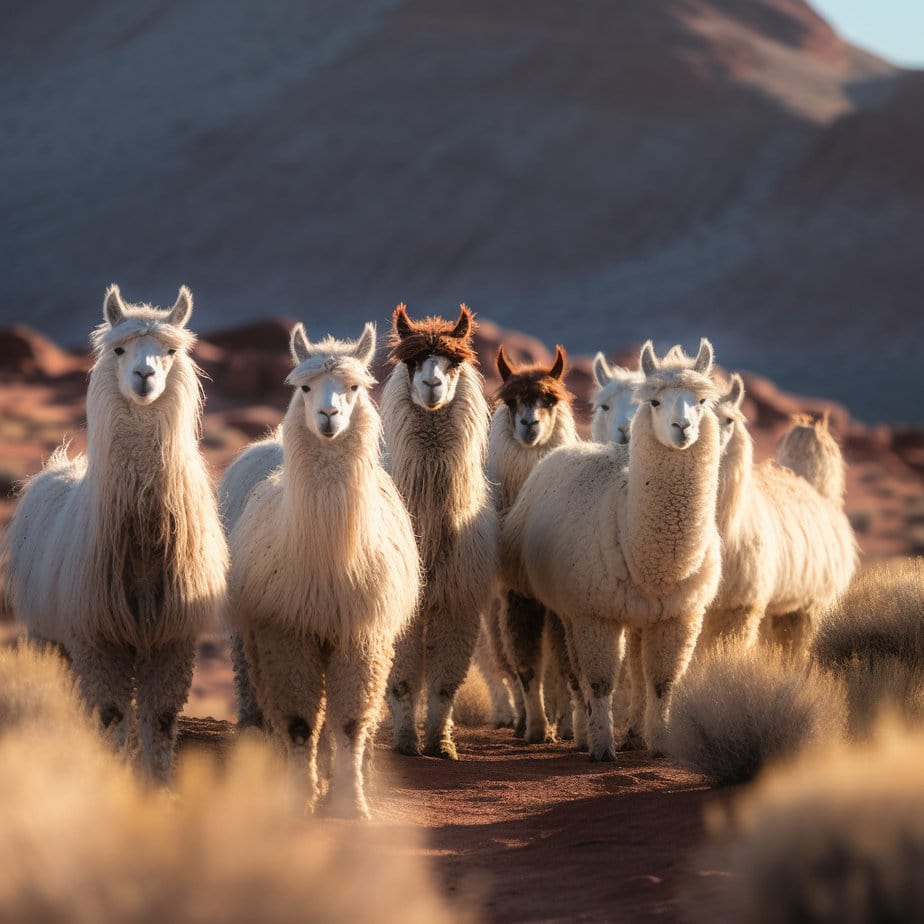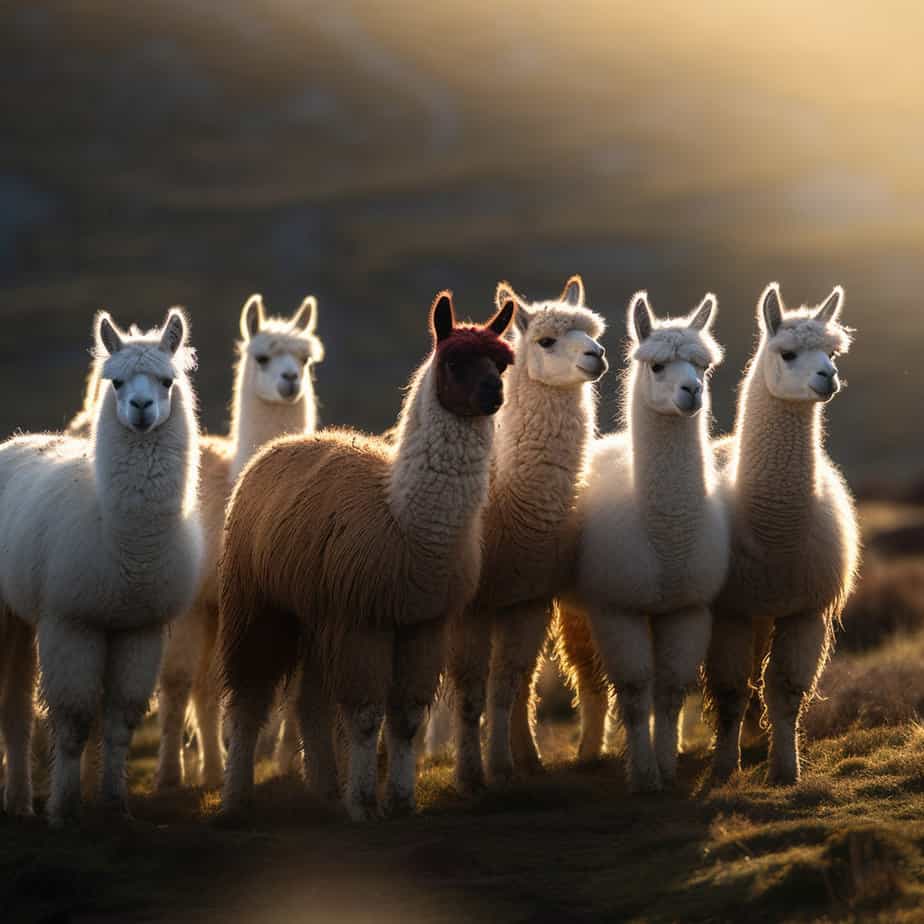Goats and llamas are two fascinating animals that have captured the attention of humans for centuries. These creatures are not only adorable but also serve various purposes in our lives. From providing us with milk, meat, and fiber to being used as pack animals and even therapy animals, goats and llamas have proven to be versatile and valuable additions to our world. In this article, we will explore the characteristics, uses, and benefits of these remarkable animals, shedding light on why they are beloved by so many. So, let’s dive in and discover the wonders of goats and llamas.
Key Takeaways
- Goats and llamas are both domesticated animals that have been used for various purposes throughout history.
- Goats are known for their ability to adapt to different environments and their high fertility rates.
- Llamas are known for their strength, agility, and ability to carry heavy loads.
- Both goats and llamas are herbivores and have unique dietary needs.
- Goats and llamas can be used for their meat, milk, fiber, and as companion animals.
- Proper care and management are essential for the health and well-being of goats and llamas.
The Intriguing World of Goats and Llamas
A. Understanding the Basic Characteristics of Goats
Goats are fascinating creatures that have been domesticated for thousands of years. They are known for their agility, curiosity, and their ability to adapt to various environments. Let’s delve into some of the basic characteristics of goats that make them such interesting animals.
1. Versatile and Hardy
Goats are incredibly versatile animals that can thrive in a wide range of climates and terrains. Whether it’s the rugged mountains, arid deserts, or lush pastures, goats have the ability to adapt and find sustenance. Their hardy nature allows them to withstand harsh conditions and forage for food in areas where other livestock may struggle.
2. Social Animals
Goats are highly social animals that thrive in herds. They have a strong sense of hierarchy within their group and establish a pecking order. This social structure helps maintain order and reduces conflicts within the herd. Goats also display a remarkable ability to communicate with each other through various vocalizations, body language, and scent marking.
3. Excellent Climbers and Jumpers
One of the most remarkable characteristics of goats is their exceptional climbing and jumping abilities. They have a natural instinct to explore their surroundings, often scaling steep cliffs and rocky outcrops with ease. Their muscular build, flexible joints, and specialized hooves enable them to navigate challenging terrains effortlessly.
4. Varied Diet
Goats are known for their diverse and adaptable diet. They are classified as browsers, which means they prefer to eat leaves, twigs, and shrubs rather than grazing on grass. This unique feeding behavior allows goats to consume a wide variety of plant species, making them valuable in controlling invasive vegetation and maintaining ecological balance in certain ecosystems.
5. Productive and Resourceful
Goats are highly productive animals that provide a range of valuable products. They are commonly raised for their milk, meat, and fiber. Goat milk is rich in nutrients and is often used to make cheese, yogurt, and other dairy products. Goat meat, known as chevon, is lean and flavorful. Additionally, goats produce high-quality fiber, such as mohair and cashmere, which is used in the textile industry.
B. Delving into the Unique Traits of Llamas
Llamas are intriguing animals that have captured the attention of people around the world. With their distinctive appearance and gentle demeanor, llamas have become popular as both farm animals and companion pets. Let’s explore some of the unique traits that make llamas so fascinating.
1. Natural Guardians
Llamas are natural guardians and have been used for centuries to protect livestock from predators. Their large size, alertness, and territorial nature make them effective deterrents against potential threats. Llamas have a strong instinct to protect their herd and will often chase away predators, such as coyotes or dogs. They are particularly known for their ability to bond with and protect smaller animals, such as sheep or goats.
2. Calm and Gentle Temperament
Llamas have a reputation for their calm and gentle temperament. They are generally docile and easy to handle, making them suitable for various purposes, including therapy animals and trekking companions. Llamas have a natural curiosity and are known to be intelligent animals, which contributes to their ability to form strong bonds with humans.
3. Low Maintenance
Llamas are relatively low-maintenance animals compared to other livestock. They have simple dietary requirements, mainly consisting of grass, hay, and fresh water. Llamas are efficient grazers and can make use of marginal pastures. They also have a unique digestive system that allows them to efficiently extract nutrients from their food, reducing the need for additional supplements.
4. Valuable Fiber
One of the most prized traits of llamas is their luxurious fiber. Llama wool is soft, warm, and hypoallergenic, making it highly sought after in the textile industry. Llamas produce a range of natural fiber colors, including white, black, brown, and shades of gray. The fiber can be spun into yarn and used to create a variety of products, such as clothing, blankets, and rugs.
5. Pack Animals
Llamas have a long history of being used as pack animals. Their strong backs and surefootedness make them ideal for carrying loads on treks and hikes. Llamas can comfortably carry up to 25% of their body weight, making them a valuable asset for outdoor enthusiasts and adventurers. Their calm demeanor and ability to navigate challenging terrains make them reliable companions on long journeys.
In conclusion, goats and llamas are captivating animals with unique characteristics that make them stand out in the animal kingdom. Whether it’s the versatility and hardiness of goats or the natural guardianship and valuable fiber of llamas, these animals continue to intrigue and inspire people around the world.
The Relationship Between Goats and Llamas
A. Exploring the Commonalities Between Goats and Llamas
When it comes to farm animals, goats and llamas are two popular choices for many farmers and animal enthusiasts. While they may seem like an odd pairing at first, goats and llamas actually share some interesting similarities. Let’s take a closer look at what these two animals have in common.
1. Social Animals
Both goats and llamas are social creatures that thrive in the company of others. They enjoy being part of a herd or flock and rely on social interactions for their well-being. Goats are known for their playful and curious nature, often engaging in friendly head-butting and climbing on objects. Llamas, on the other hand, are known for their calm and gentle demeanor, making them great companions for other animals.
2. Grazers
Another similarity between goats and llamas is their diet. Both animals are herbivores and primarily graze on grass and other vegetation. They have a similar digestive system that allows them to efficiently extract nutrients from plant material. This makes them well-suited for grazing in pastures and can be beneficial for maintaining the health of the land.
3. Hardy and Adaptable
Both goats and llamas are known for their hardiness and adaptability to various climates and terrains. Goats, in particular, are highly resilient animals that can thrive in harsh environments. They have a remarkable ability to find food in even the most challenging landscapes. Llamas, on the other hand, are well-adapted to the high altitudes and rugged terrains of the Andes Mountains, where they originate from.
B. Unveiling the Differences: Goats vs Llamas
While goats and llamas share some similarities, they also have distinct characteristics that set them apart. Let’s explore some of the key differences between these two fascinating animals.
1. Size and Appearance
One of the most noticeable differences between goats and llamas is their size and appearance. Goats are generally smaller animals, with an average height ranging from 17 to 42 inches at the shoulder. They come in a variety of breeds, each with its own unique physical characteristics. Llamas, on the other hand, are much larger, standing at an average height of 5 to 6 feet at the shoulder. They have a slender build, long necks, and distinctive banana-shaped ears.
2. Behavior and Temperament
Goats and llamas also differ in their behavior and temperament. Goats are known for their mischievous and curious nature. They are agile climbers and can often be found perched on fences or even trees. Llamas, on the other hand, are known for their calm and gentle temperament. They are highly alert animals and have a natural instinct to protect their herd from potential threats.
3. Uses and Purposes
Both goats and llamas have been domesticated for various purposes. Goats are primarily raised for their milk, meat, and fiber. They are also used for weed control and as companion animals. Llamas, on the other hand, are often kept as pack animals and used for trekking and hiking. Their wool is highly prized for its softness and warmth, making it ideal for clothing and textiles.
In conclusion, while goats and llamas may have some commonalities, they also have distinct differences that make each of them unique. Whether you’re considering raising goats for milk or llamas for trekking, both animals offer their own set of benefits and rewards. Understanding their similarities and differences can help you make an informed decision when it comes to choosing the right animal for your farm or homestead.
The Compatibility of Goats and Llamas: Can They Live Together?

A. The Dynamics of Goats and Llamas Living Together
When it comes to raising livestock, many farmers and animal enthusiasts often wonder if goats and llamas can live together harmoniously. While goats and llamas have different characteristics and behaviors, they can indeed coexist and even form a beneficial partnership on the farm. Let’s explore the dynamics of goats and llamas living together.
1. Natural Guardian Instincts
Llamas are known for their natural guardian instincts. Originating from the Andes Mountains, these large, gentle creatures have been used for centuries to protect livestock from predators such as coyotes and dogs. Llamas are highly alert and will often sound the alarm when they sense danger approaching. This makes them excellent companions for goats, as they can help deter potential threats and keep the flock safe.
2. Complementary Behaviors
Goats and llamas also have complementary behaviors that make them compatible. Goats are known for their curiosity and agility, often exploring their surroundings and testing boundaries. On the other hand, llamas are more cautious and tend to be more reserved. This balance can be advantageous, as goats can help encourage llamas to explore new areas, while llamas can help keep goats in check and prevent them from wandering too far.
3. Social Hierarchy
Both goats and llamas have a social hierarchy within their respective herds. Goats establish a pecking order, with dominant individuals asserting their authority over others. Llamas, on the other hand, have a more relaxed social structure, with less aggression and competition for dominance. When introducing goats and llamas, it is essential to consider their social dynamics and ensure that the hierarchy is respected to avoid any conflicts.
B. Factors Influencing the Compatibility of Goats and Llamas
While goats and llamas can generally live together harmoniously, several factors can influence their compatibility. It is crucial to consider these factors when deciding to introduce goats and llamas on your farm.
1. Size and Space Requirements
Goats and llamas have different size requirements and space needs. Goats are smaller and more agile, requiring less space to roam and graze. Llamas, being larger animals, need more room to move around comfortably. It is essential to provide adequate space for both species to ensure their well-being and prevent overcrowding.
2. Nutritional Needs
Goats and llamas have different nutritional needs. Goats are browsers and prefer to eat a variety of plants, shrubs, and trees. Llamas, on the other hand, are grazers and primarily consume grass. It is crucial to provide a balanced diet that meets the specific dietary requirements of both goats and llamas to ensure their optimal health.
3. Health Considerations
When introducing goats and llamas, it is essential to consider their health and well-being. Goats are susceptible to certain diseases, such as parasites, which can also affect llamas. Regular veterinary care, including vaccinations and deworming, is crucial for both species. Additionally, providing separate mineral supplements tailored to the specific needs of goats and llamas can help maintain their overall health.
In conclusion, goats and llamas can live together harmoniously, benefiting from each other’s unique characteristics and behaviors. By understanding the dynamics of their relationship and considering factors such as size, space, nutrition, and health, farmers and animal enthusiasts can successfully integrate goats and llamas on their farms, creating a thriving and diverse livestock community.
The Interactions Between Goats and Alpacas: A Comparative Study

A. Understanding the Relationship Between Goats and Alpacas
When it comes to the animal kingdom, the interactions between different species can be fascinating to observe. One such intriguing relationship is the one between goats and alpacas. While goats and alpacas may seem like an unlikely pair, they can actually form a harmonious bond when kept together. Let’s delve deeper into understanding this unique relationship.
1. Complementary Behaviors
Goats and alpacas have distinct behaviors that complement each other. Goats are known for their curious and adventurous nature. They are excellent climbers and can navigate rocky terrains with ease. On the other hand, alpacas are more cautious and alert. They have a natural instinct to protect their herd from potential threats. This combination of traits can create a balanced dynamic between the two species.
2. Predator Protection
One of the main reasons why goats and alpacas are often kept together is their ability to protect each other from predators. While goats are vulnerable to predators such as coyotes and dogs, alpacas have a natural instinct to be on guard and protect their herd. Alpacas are larger in size compared to goats, which acts as a deterrent to potential predators. Their presence can help deter predators from approaching the flock, keeping the goats safe.
3. Companionship and Social Structure
Goats and alpacas are social animals that thrive in the company of others. When kept together, they form a strong bond and establish a social structure within the group. Alpacas are known to be gentle and calm animals, which can have a calming effect on goats. This companionship can help reduce stress and anxiety in both species, leading to a more harmonious environment.
B. Factors Affecting the Harmony Between Goats and Alpacas
While goats and alpacas can coexist peacefully, there are certain factors that can affect the harmony between them. It is important for owners and caretakers to be aware of these factors to ensure the well-being of both species.
1. Fencing and Shelter
Proper fencing and shelter are essential when keeping goats and alpacas together. While goats are known for their agility and ability to escape, alpacas are less likely to attempt to jump over fences. Therefore, the fencing should be designed to contain goats while providing adequate space for alpacas to move around comfortably. Additionally, both species require shelter to protect them from extreme weather conditions.
2. Nutrition and Feeding
Goats and alpacas have different nutritional needs. Goats are browsers and prefer to eat leaves, shrubs, and grass. They require a diet rich in fiber. On the other hand, alpacas are grazers and primarily feed on grass. They have a lower tolerance for copper, so their diet should be carefully monitored to prevent copper toxicity. Providing separate feeding areas for goats and alpacas can ensure that each species receives the appropriate nutrition.
3. Health and Veterinary Care
Both goats and alpacas require regular health check-ups and veterinary care. It is important to have a veterinarian who is knowledgeable about both species to address any health concerns. Additionally, goats and alpacas may have different vaccination requirements, so it is crucial to follow the appropriate vaccination schedule for each species. Regular monitoring of their overall health and well-being is essential to maintain a harmonious environment.
In conclusion, the interactions between goats and alpacas can be mutually beneficial when certain factors are taken into consideration. Understanding their relationship, providing appropriate fencing and shelter, ensuring proper nutrition, and prioritizing their health and veterinary care are key to maintaining a harmonious coexistence. By fostering a balanced environment, goats and alpacas can thrive together, creating a unique and fascinating dynamic within the animal kingdom.
The Practicalities of Keeping Goats and Llamas Together

A. Essential Considerations for Housing Goats and Llamas Together
When it comes to keeping goats and llamas together, there are a few essential considerations to keep in mind. While these two animals can coexist harmoniously, it’s important to ensure their housing and care needs are met to maintain a peaceful environment for both species.
1. Space Requirements
One of the first things to consider is the amount of space needed to house goats and llamas together. Both goats and llamas require ample room to roam and graze. A general rule of thumb is to provide at least 200 square feet per goat and 100 square feet per llama. This will allow them to move around comfortably and engage in their natural behaviors.
2. Fencing
Proper fencing is crucial when housing goats and llamas together. Goats are known for their mischievous nature and ability to escape, while llamas are excellent jumpers. To prevent any unwanted adventures, it’s recommended to use sturdy fencing that is at least 4 to 5 feet high. Additionally, make sure the fencing is secure at the bottom to prevent goats from squeezing through or under it.
3. Shelter
Both goats and llamas require shelter to protect them from extreme weather conditions. A sturdy and well-ventilated shelter is essential to provide them with a safe and comfortable space. The shelter should be large enough to accommodate all the animals and should have separate areas for goats and llamas, as they have different preferences for bedding and resting.
4. Feeding and Nutrition
Goats and llamas have different dietary needs, so it’s important to provide them with appropriate feed and nutrition. Goats are browsers and prefer to eat leaves, twigs, and shrubs, while llamas are grazers and primarily eat grass. Ensure that each animal has access to their preferred food sources and provide them with a balanced diet that meets their nutritional requirements.
B. Tips for Ensuring a Peaceful Coexistence Between Goats and Llamas
While goats and llamas can live together peacefully, it’s important to take certain steps to ensure a harmonious coexistence between the two species. Here are some tips to help you achieve that:
1. Introduce Them Gradually
When introducing goats and llamas, it’s best to do so gradually. Start by allowing them to see and smell each other through a fence before allowing direct contact. This gradual introduction will help them become familiar with each other’s presence and reduce the chances of any aggressive behavior.
2. Provide Adequate Resources
To prevent competition and potential conflicts, make sure to provide enough resources for both goats and llamas. This includes food, water, and shelter. Having multiple feeding stations and water troughs will help ensure that each animal has access to what they need without feeling threatened by the other.
3. Monitor Their Interactions
Keep a close eye on the interactions between goats and llamas, especially during the initial stages of their cohabitation. While they generally get along well, occasional conflicts may arise. If you notice any signs of aggression or bullying, it’s important to intervene and separate the animals if necessary.
4. Regular Veterinary Care
Just like any other livestock, goats and llamas require regular veterinary care. Schedule routine check-ups and vaccinations to ensure their health and well-being. Regular veterinary care can help detect and prevent any potential health issues before they become more serious.
By considering these essential factors and following these tips, you can create a harmonious living environment for both goats and llamas. With proper care and attention, these two species can coexist and thrive together on your farm or homestead.
The Fascinating Phenomenon of ‘Llamas with Hats’
A. Decoding the Significance of ‘Llamas with Hats’
If you’ve spent any time on the internet, chances are you’ve come across the viral sensation known as “Llamas with Hats.” This quirky animated series, created by Jason Steele, has captivated audiences with its dark humor and unexpected twists. But what exactly is the significance behind these llamas wearing hats?
At its core, “Llamas with Hats” is a satirical take on human behavior and morality. The main characters, Carl and Paul, are llamas who engage in increasingly bizarre and morally questionable activities. Through their actions, the series explores themes of friendship, loyalty, and the consequences of one’s choices.
The hats worn by the llamas serve as a visual representation of their personalities. Carl, the more impulsive and destructive of the two, dons a top hat, symbolizing his desire for power and control. On the other hand, Paul wears a simple beanie, reflecting his more reserved and cautious nature. The contrast between their headwear mirrors their conflicting personalities and sets the stage for their comedic interactions.
B. The Impact of ‘Llamas with Hats’ on Goat and Llama Interactions
While “Llamas with Hats” may seem unrelated to goats and llamas, it has inadvertently had an impact on how people perceive these animals and their interactions. The series has garnered a significant following, leading to increased interest in llamas and goats as pets, therapy animals, and even farm companions.
Llamas, in particular, have gained attention as effective guardians for livestock. Their large size and natural instincts make them excellent protectors against predators such as coyotes and dogs. Llamas are often able to detect danger before it reaches the flock and may even attempt to chase away potential threats. This unique ability has made them popular among farmers and livestock owners who need reliable guardians for their animals.
Goats, on the other hand, have been recognized for their versatility. They can be used for milk production, meat, fiber (such as wool), and even as pack animals. Goat farming has become a lucrative industry, with various breeds offering different benefits. Additionally, goats are known for their playful and curious nature, making them popular as pets and therapy animals.
The popularity of “Llamas with Hats” has shed light on the unique characteristics and behaviors of llamas and goats. People are now more aware of the benefits these animals can bring to their lives, whether it’s through their role as guardians, providers of milk and wool, or simply as companions. This increased interest has led to a greater appreciation for animal husbandry and the importance of responsible care for farm animals.
In conclusion, “Llamas with Hats” may have started as a quirky internet phenomenon, but its impact on goat and llama interactions cannot be denied. By decoding the significance behind the llamas‘ headwear and exploring the consequences of their actions, the series has sparked curiosity and appreciation for these remarkable animals. Whether you’re considering adding a llama to your farm or simply enjoying the comedic escapades of Carl and Paul, “Llamas with Hats” has undoubtedly left its mark on the world of goats and llamas. Conclusion
In conclusion, goats and llamas are fascinating animals that have been domesticated for centuries. Both species have unique characteristics and provide various benefits to humans. Goats are versatile creatures that can adapt to different environments and are valued for their milk, meat, and fiber. They are also known for their agility and climbing abilities. On the other hand, llamas are gentle and intelligent animals that are often used as pack animals and for their soft wool. They are known for their calm temperament and their ability to bond with humans. Despite their differences, both goats and llamas play important roles in agriculture, tourism, and even therapy. Whether you’re considering raising goats for their milk or enjoying the companionship of a llama, these animals can bring joy and utility to our lives. So, whether you’re a farmer, a nature enthusiast, or simply someone who appreciates the beauty of these creatures, goats and llamas are definitely worth learning more about and experiencing firsthand.
Frequently Asked Questions
Can llamas live with goats?
Yes, llamas and goats can live together. They both have similar requirements in terms of shelter and grazing. Llamas are often used as guard animals for goats as they are known to protect smaller animals from predators.
Do goats and alpacas get along?
Generally, goats and alpacas get along well. They can share the same pasture and shelter. However, it’s important to monitor their interactions, especially in the beginning, to ensure they are getting along.
Are llamas related to goats?
No, llamas and goats are not directly related. Llamas belong to the camelid family, which includes camels and alpacas, while goats are part of the bovidae family, which also includes sheep and cows.
What is the difference between a llama and a goat?
Llamas and goats have several differences. Llamas are larger, have a longer lifespan, and are primarily used for carrying loads and producing wool. Goats, on the other hand, are smaller, have a shorter lifespan, and are primarily kept for milk and meat production.
Can you keep goats and llamas together?
Yes, you can keep goats and llamas together. They can share the same pasture and shelter, and llamas can even act as guard animals for goats.
Do goats and llamas get along?
Yes, goats and llamas generally get along well. They have similar grazing habits and can share the same space. However, it’s important to monitor their interactions to ensure they are getting along.
What are the benefits of llama wool?
Llama wool is known for its softness, warmth, and durability. It’s hypoallergenic and does not contain lanolin, which makes it a great option for people with sensitive skin or allergies.
What are some popular goat breeds for farming?
Some popular goat breeds for farming include the Nubian, Alpine, Saanen, and Boer. The choice of breed depends on whether the farm is focused on milk production, meat production, or both.
How is llama trekking?
Llama trekking is a unique and enjoyable experience. Llamas are used to carry supplies, which makes them perfect companions for long hikes. They are gentle and easy to handle, making the trekking experience fun and stress-free.
What are the benefits of goat milk products?
Goat milk products, such as cheese and yogurt, are highly nutritious. They are easier to digest compared to cow’s milk products and are a good source of protein, calcium, and several other essential nutrients.




